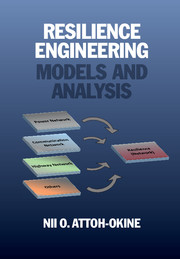Book contents
- Frontmatter
- Contents
- Preface
- Acknowledgments
- PART I INTRODUCTION
- PART II INFRASTRUCTURE SYSTEMS
- 2 Infrastructure Systems
- 3 Disruptions
- 4 Graphs and Networks
- 5 Big Data and Resilience Engineering
- 6 Graphical Models
- 7 Belief Functions
- 8 Tensors Applications
- 9 Resilience Index—Selected Examples
- 10 Epilogue
- Index
- References
10 - Epilogue
from PART II - INFRASTRUCTURE SYSTEMS
Published online by Cambridge University Press: 05 March 2016
- Frontmatter
- Contents
- Preface
- Acknowledgments
- PART I INTRODUCTION
- PART II INFRASTRUCTURE SYSTEMS
- 2 Infrastructure Systems
- 3 Disruptions
- 4 Graphs and Networks
- 5 Big Data and Resilience Engineering
- 6 Graphical Models
- 7 Belief Functions
- 8 Tensors Applications
- 9 Resilience Index—Selected Examples
- 10 Epilogue
- Index
- References
Summary
General
Resilience engineering is now a new paradigm that cannot be overlooked in critical infrastructure modeling, control, and decision making. The initial concept was based on the edited work by Hollnagel et al. (2006), which was more focused on human errors, machine failures, and safety critical systems involving humans. Recently, resilience engineering has been referred to as the art of managing the unexpected or how teams or organizations become prepared to cope with surprises. These surprising events can sometimes push the system beyond its operational boundaries (Woods 2006). Therefore, the purpose of resilience engineering is to anticipate the changing potential for failure considering that plans and procedures have limits, gaps, and unforeseen errors and that the environment is very dynamic (Hollnagel et al. 2006).
Networked and lifeline infrastructure appear to be one of the great challenges, especially in the presence of a surprise event. Designing resilient systems can limit and reduce the probability of failure and its consequences. Currently, there are a few metrics for evaluating resilience of standalone infrastructures and their interdependencies, but they are very limited and inconsistent. The most successful metrics are when only two infrastructure systems are interacting. Furthermore, there is no standard or a universal method of developing and analyzing the resilience indices of more than two interacting infrastructures or systems of interdependent networks. Buldyrev et al. (2010) and Leicht and D'Souza (2009) are a few examples of researchers leading the development of consistent and objective methods for analyzing interdependent networks. Resilience engineering is becoming a new paradigm for complex systems performance and maintenance decision making, and the resilience engineering principle fits within the sustainability framework.
Looking Back
Proper formulating and analyzing of resilience engineering problems and applications requires a strong background in graph theory, statistics, and machine learning algorithms. Also resilience indices are time-dependent metrics. The majority of the ideas presented in the book are toward infrastructure systems and general networks. It would be incorrect to use one metric to determine the resilience index of the systems, since for identical systems, a slightly different resilience index under different time conditions; therefore, the resilience index should be used as a guide. For example, in more sophisticated methods developed by physicists, there are many assumptions in the question used that will ultimately affect the final results.
Information
- Type
- Chapter
- Information
- Resilience EngineeringModels and Analysis, pp. 150 - 152Publisher: Cambridge University PressPrint publication year: 2016
